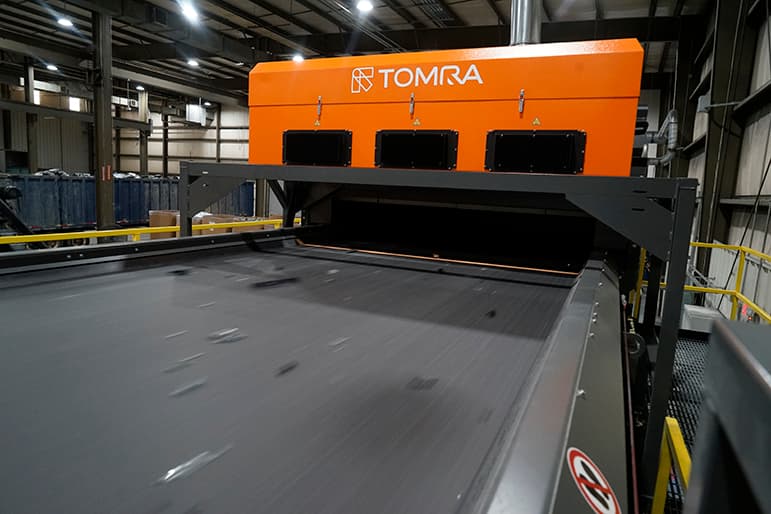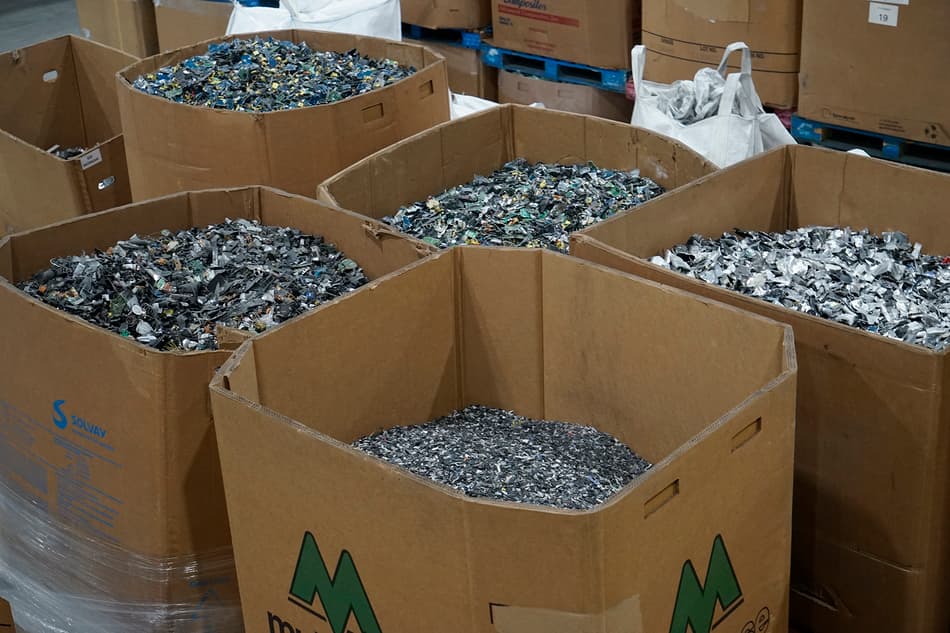
Automation triples processing capacity
Premier Surplus automates E-waste processing with TOMRA AUTOSORT® FINES to take efficiencies to the next level
Electronics waste processing is extremely challenging. The material feed landscape is ever-changing with varied circuit board colors and multiple types of plastics used in electronics. “Manufacturers are producing green, yellow, blue and red circuit boards, and we even see some black circuit boards now,” comments Phillip Kennedy, VP of Premier Surplus, Dawsonville, Ga.

The company traces its origins nearly 20 years ago, when Phillip and his wife, Stephanie, worked the business out of their garage. In an era before smart phones, they teamed up to successfully bid and purchase used electronics. He traveled to auctions and phoned Stephanie, who would research the value of items online. This allowed Phillip to know what to buy and what to bid on the items.
What electronics could be refurbished were remarketed on eBay, but there was one catch. They had to buy in bulk, and the pallets of electronics included many electronics that could not be resold. “We had to find a way to generate value for the leftovers,” says Kennedy. Recycling these left-over electronics was the genesis of Premier Surplus.
Rapid growth
Through trial and error, they quickly learned the E-Scrap business and became more efficient in recycling what could not be refurbished, even though everything was processed manually. They moved operations to a larger shed and then again to a 20,000-ft2 (1,858-m2) facility. It is at that point Premier Surplus added a shredder to increase E-Scrap sorting efficiency. Taking in and processing more material, the company again moved into a larger, 50,000-ft2 (4,645-m2) facility.
Part of Premier Surplus’s growth was driven by bringing on new accounts to keep a consistent flow of materials. “We have a good portfolio of customers, which includes manufacturers, schools, governmental agencies and larger corporations,” says Kennedy. Mark Neitzey, national sales director for Van Dyk Recycling Solutions, Norwalk, Conn., adds, “I’m really impressed by how well Premier Surplus knows the business and by their passion. Many of the employees know every job within the company, and they all do the work well.”
The second part of the success story was finding customers to purchase recycled materials. Early on, the company discovered they needed to increase volume to reach certain customers. “We spoke to smelters to see they would accept 8,000 lb (3,629 kg) of material a month. They required 25,000 lb (11,340 kg) per month before they would consider us,” explains Kennedy.

Around the same time, Premier Surplus noticed a change in the E-Scrap material flow to smaller items such as modems, printers and telephones. Often these smaller items would be disassembled and recycled by hand, but the increase in Premier Surplus’s material volume made this impractical. “You can recycle a modem by hand pretty efficiently, but you cannot get caught up if you have thousands waiting,” adds Kennedy.
The company processed about 20,000 lb. (9,072 kg) of E-Scrap a day with manual sorting after shredding and screening. Hand sorting, however, limited growth potential. “Premier Surplus needed a complete automated circuit with an optical sorter to take their operation to the next level,” adds Eric Thurston, sales manager metals – recycling for TOMRA Sorting, Inc.

Automated circuit featuring TOMRA
The most recent expansion for Premier Surplus, the largest family-owned E-Scrap recycling operation in the state of Georgia, saw a move to a 137,000-ft2 (62,142-m2) facility to house multiple divisions, including a new automated shredding and sorting circuit. Built to improve sorting efficiency, the circuit adds an eddy current station to the shredder and is anchored by the TOMRA AUTOSORT® FINES optical sorter to increase sorting accuracy and material purity.
“Our metals customers only want metals and our plastics customers only plastic. That is what AUTOSORT® (FINES) delivers,” says Kennedy. The automated circuit expanded E-Scrap processing capacity by 300% versus manual sorting. The operation now recycles up to 60,000 lb (27,216 kg) of E-Scrap every day and, in 2019, recycled 20 million lb (9,071,874 kg) of material.
Prior to selecting each component to make up the automated sorting system, Kennedy extensively researched the different components to make sure he purchased the right sorting solution for current and future needs. He also enlisted the E-Scrap recycling expertise of Peter Prinz, owner of Prinz Consulting, who has 45 years of scrap and material recycling experience.
The installed 217-ft (66.1-m) long circuit includes an SSI triple-shaft shredder to effectively liberate the material. A post-shredder screen removes fine material from the stream, and a cross-belt magnet removes clean metal from the screenings. “Pulling the fines from the flow at the beginning helps to improve the circuit’s efficiency,” comments Thurston. The remaining material is conveyed to a Javelin eddy current machine for aluminum and copper recovery prior to sending material to the optical sorter for enhanced separation.
“I recommend the best components for E-Scrap processing, and over the last 16 years, I’ve found TOMRA sorting equipment excels in E-Scrap applications,” says Prinz. “TOMRA offers 30-40% better recovery than other sorters, and AUTOSORT® (FINES) will recover about 75-90% on the first pass.” The optical sorter gives Premier Surplus the ability to selectively sort plastics, lower grade PCBs, wire and metals with high purity.
Premier Surplus worked with TOMRA and its plant building partner, Van Dyk, to purchase and install the AUTOSORT® FINES plus supporting components. TOMRA and Van Dyk technicians worked with Premier Solutions’ employees on proper sorter operation and to help create different programs for sorting varied materials. The plant builder also provides ongoing support of the optical sorter. “Van Dyk offers excellent support, 24-hour service if necessary,” comments Kennedy.
Beyond the technology and support, there was one intangible that drew Kennedy to TOMRA for anchoring the automated sorting circuit. “TOMRA doesn’t just make equipment. They have a work culture focused on recycling,” he says. “They are committed to the plastics crisis, sustainable technology and the circular economy.”

Ever evolving feed
Kennedy says the flexibility of AUTOSORT® FINES’ technology helps Premier Surplus earn its success, since the E-Scrap material stream is constantly changing. “Manufacturers are using green, yellow, blue, red and brown circuit boards, and that is the primary product our customers want,” he says.

AUTOSORT® FINES combines electromagnetic, near infrared (NIR) and visible spectroscopy (VIS) technologies to selectively sort feed by color and material composite. “Our FLYING BEAM® technology evenly distributes the light over the entire belt for better recognition. The sensor detects the specific wavelength of light in NIR and algorithms classify the material to decide whether to drop or eject material,” explains Thurston.
During the initial sort, Premier Surplus drops the plastic and ejects circuit boards, wire and non-ferrous material. “We are getting about 95% material recovery on the first pass, which is better than we anticipated,” says Kennedy. Neitzey adds, “AUTOSORT® FINES makes it easy for Premier Surplus to run the ejected materials for further processing, which is a huge benefit.” This enables the company to sort product packages, such as low-grade PCBs, wire, stainless and metals.
Kennedy explains that Premier Surplus has created their own “recipes” for running batches of materials such as printers, set-top boxes or automation equipment. AUTOSORT® FINES identifies the material to be removed from the stream to create a good, clean final product. “The machine’s customer interface stores different sorting programs and allows the operator to quickly switch between programs to match the material stream,” explains Thurston.
A year and a half into operating the new circuit, there is no second guessing that Premier Surplus made the right equipment selection for the automated circuit. “We definitely made the right choice with TOMRA. I really have to give thanks and praises to everyone that was involved in this project,” says Kennedy. “The demand for properly recycling e-waste is there. That is why the Premier Surplus team stands ready to do our part in keeping material out of the landfill and, at the same time, protecting our customers’ data and reputation.”
